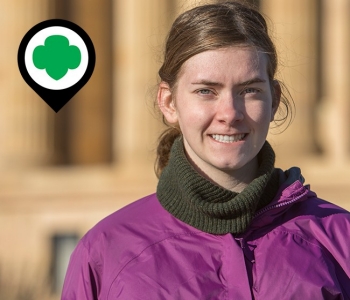Meet Sadhana A: She Puts the Innovator in G.I.R.L.

The young women featured in this series have not only earned Girl Scouts’ highest honor by being named 2016 National Young Women of Distinction—they also serve as incredible examples of what it means to be a G.I.R.L. (Go-getter, Innovator, Risk-taker, Leader)™.
I’m now a freshman at the University of Miami, studying biochemistry and health care policy—but before that, I was a Girl Scout for six years, something I took and still take very seriously. And of all the important things I learned during those years, two words stick with me more than anything else: Take Action.
It was Girl Scouts that really instilled in me the idea that we can take the knowledge we have and the skills we learn and put them to practical use in the real world, even from a young age. I’ve always been interested in science, but simply paying attention in class and focusing on those subjects in school wasn’t enough for me, so I started volunteering with the North Carolina Museum of Natural Sciences when I was in the seventh grade. I loved getting hands-on experience with the scientific concepts I was learning and getting to know the people who worked there in their micro-lab.
Around the time I was starting to think about my Girl Scout Gold Award project, Ebola was in the news all the time. People were afraid and really misinformed. Kids at my school had no idea how it spread or what their chances were of contracting it, and many of them were really scared. I wanted to help stop the myths around the virus and help young people understand what it really was, and also to learn about some of the biological and chemical concepts that go into diagnosing it.
So, with the help of the team at the North Carolina Museum of Natural Sciences, I created a simulation of a diagnostic test for Ebola that even elementary-school-aged children could use and learn from. Now, when classes come on field trips to the museum, students can take part in a very realistic diagnosis, modeled on what scientists actually use to identify the Ebola virus (and now Zika virus, too!) in patients.
Today, I take pride in knowing that thousands of people have now had a hands-on experience with my exhibit. Of course I hope that students walk away knowing a lot more about Ebola and how the virus is diagnosed, but I also hope that it inspires students to take the knowledge they gain in the classroom and apply it to our world. The concepts we’re being taught aren’t just important for us to remember because they’ll help us get a good grade on a test, they’re important because when we think of creative and impactful ways to use them in our communities and in society in general, we can really make a difference and change people’s lives. Girl Scouts taught me that in so many ways, and I’m happy to have shared that with so many other students through my Gold Award project.





